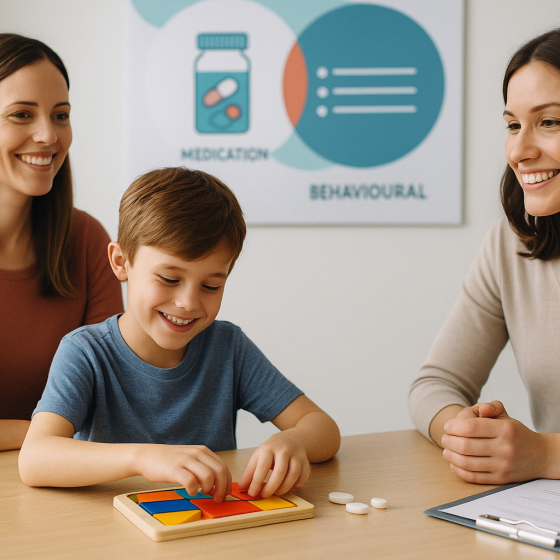Are we overmedicating or misframing ADHD?
Record high diagnosis rates have reignited debate over what ADHD really is and how best to treat it.
Australia’s 2022 Evidence Based Clinical Practice Guideline shifts the focus from symptom tallies to everyday functioning, urging clinicians to blend medication, psycho-education, school supports and lifestyle change into one plan (Australian ADHD Guideline Development Group, 2022).
Yet prescriptions keep climbing: U.S. insurance data show a 14% jump in adult stimulant fills in a single year (2020–2021), with women driving much of the rise (Danielson et al., 2023).
Recently, The New York Times Magazine sharpened the conversation by highlighting three uncomfortable truths (Tough, 2025).
First, the promised “biomarkers” of ADHD, distinct EEG signatures or single gene flags have failed to replicate, so diagnosis remains behavioural.
Second, the landmark Multimodal Treatment Study (MTA) found that the early edge of intensive medication over behavioural therapy vanished by Year 3, while consistent stimulant use was linked to mild growth suppression and adolescents still lagged non ADHD peers on 91% of functional measures (MTA Cooperative Group, 2009).
Third, environmental stressors such as sleep loss, poverty and tablet saturated classrooms can masquerade as inborn neurobiological deficits yet are at times insufficiently appraised before the first script is written.
Critics argue that an over medicalised lens pathologises ordinary struggle and lets under resourced schools and workplaces off the hook.

Long term safety, however, looks reassuring.
The two year ADDUCE cohort detected no signal for major neurological, psychiatric or cardiovascular harm from sustained methylphenidate use, though modest rises in heart rate and blood pressure justify annual checks (Man et al., 2023).
Nevertheless, the World Health Organization again declined to add methylphenidate to its 2023 Essential Medicines List, underscoring persistent global inequity in access (World Health Organization, 2023).
How effective are stimulants, really?
A 2023 Cochrane review of 212 randomised trials (16,302 participants) reported a pooled standardised mean difference of –0.77 for teacher rated symptoms and a number needed to treat of just three for noticeable improvement, with adverse effects mostly mild and transient (Storebø et al., 2015).
The largest network meta analysis to date (>10,000 individuals) ranked methylphenidate as the optimal first line agent in youth and amphetamines in adults when balancing efficacy and tolerability (Cortese et al., 2018).
Beyond symptom checklists, observational follow-ups link cumulative stimulant exposure to better social emotional functioning and academic attainment into adulthood without detectable cognitive harm (Schweren et al., 2019).
Furthermore, quality of life gains are also robust in the short term, although long term data remain limited (Meta Analysis Review Group, 2024).
Alongside pharmacology, digital adjuncts are moving from novelty to evidence base. Early “brain training” apps produced mixed results, but CoolTaCo, a smartwatch smartphone system that streams real time behaviour data to clinicians, enters a 60 child randomised trial this year and may redefine follow up care (Cibrian et al., 2024).
At the same time, a Mendelian randomisation study links heavy recreational screen use to higher ADHD risk, reinforcing the value of deliberate “digital hygiene” (Meng et al., 2024).

Practical takeaways
- Run a full lifestyle and sleep audit before medication, repeating it at each review.
- If stimulants are used, schedule growth, blood pressure and mood checks at three months, six months then annually (Man et al., 2023).
- Combine pharmacotherapy with cognitive behavioural therapy or structured coaching; an umbrella meta analysis shows superior academic and occupational outcomes compared with drugs alone (Tsujii et al., 2023).
- Treat screens like sugar: acceptable in moderation, harmful in excess (Meng et al., 2024).
- Give teachers concrete tools and recommendations like preferential seating, task chunking, timed breaks rather than vague “monitor attention” directives (Australian ADHD Guideline Development Group, 2022).
References
- Australian ADHD Guideline Development Group. (2022). Australian Evidence Based Clinical Practice Guideline for Attention Deficit/Hyperactivity Disorder. AADPA.
- Danielson, M.L., et al. (2023). Trends in stimulant prescription fills among commercially insured children and adults—United States, 2016–2021. MMWR, 72(13), 327–332.
- Tough, P. (2025, April 13). Have we been thinking about A.D.H.D. all wrong? The New York Times Magazine.
- MTA Cooperative Group. (2009). Eight year follow up of children treated for combined type ADHD. J Am Acad Child Adolesc Psychiatry, 48:484–500.
- Man, K.K.C., et al. (2023). Long term safety of methylphenidate in children and adolescents with ADHD: two year outcomes of the ADDUCE study. Lancet Psychiatry, 10:323–333.
- World Health Organization. (2023). Model List of Essential Medicines—23rd List. Geneva: WHO.
- Storebø, O.J., et al. (2015). Methylphenidate for children and adolescents with ADHD. Cochrane Database Syst Rev, 2015(11):CD009885.
- Cortese, S., et al. (2018). Comparative efficacy and tolerability of medications for ADHD. Lancet Psychiatry, 5:727–738.
- Schweren, L., et al. (2019). Long term effects of stimulant treatment on ADHD symptoms, social emotional functioning, and cognition. Psychol Med, 49:217–227.
- Meta Analysis Review Group. (2024). Effects of ADHD medication on quality of life: systematic review and meta analysis. J Am Acad Child Adolesc Psychiatry, 63:713–726.
- Cibrian, F., et al. (2024). Digital health intervention for children with ADHD: CoolTaCo study protocol. BMC Digital Health, 4:18.
- Meng, Z., et al. (2024). Screen time and childhood ADHD: a bidirectional Mendelian randomisation study. Front Psychiatry, 15:1441191.
- Tsujii, N., et al. (2023). Combined pharmacological and behavioural treatments for ADHD: an umbrella meta analysis. Clin Psychol Rev, 102:102339.

